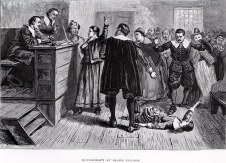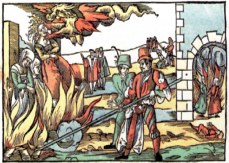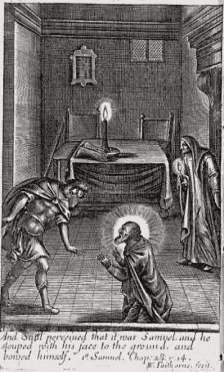Witchcraft and Witches
Witchcraft, sorcery, the practice of the "Black Art ( Magic)."
Witchcraft, traditionally refers to the use of supernatural or magical powers. It is generally considered a form of folk magic that is used for various purposes, such as healing, divination, or influencing events. The concept of witchcraft has been present in various cultures and societies throughout history, with beliefs and practices varying widely. Modern witchcraft tends to be a personal and individualistic practice, with many witches following a solitary path or joining covens (groups of practicing witches) for communal rituals and learning. Some witches identify as Wiccan, while others may draw from multiple traditions or create their own unique blend of practices. It is essential to differentiate between the historical and cultural perceptions of witchcraft and the contemporary religious practices of Wicca and other forms of modern Paganism. While witchcraft has been vilified in the past, many individuals today embrace the title of "witch" as a sign of their spiritual beliefs and connection to nature.
Witchcraft is the practice of using purported supernatural or magical powers to manipulate the world around us. It often involves the use of spells, incantations, rituals, and the invocation of deities, spirits, or other entities to bring about desired outcomes. Witchcraft is historically associated with various cultures, religions, and belief systems, including paganism, Wicca, and some forms of Satanism. It is important to note that the term "witchcraft" can have different meanings and connotations depending on the context in which it is used.
Witches are typically thought of as individuals who practice witchcraft, and often appears as a solitary individual, typically female, who has an intimate connection with nature and the supernatural. They are often depicted with characteristics such as a pointy hat, a broomstick, and a black cat with the ability to cast spells, brew potions, and interact with the spirit world. In many cultures, witches have been feared and vilified. In contemporary times, the term "witch" is often used within the context of Wicca and other modern Pagan religions. They have often been the subject of witch hunts and persecution, particularly in early modern Europe and Colonial America. These persecutions were fueled by religious and social tensions, as well as misunderstandings and fear of the unknown.
Witchcraft as practiced in Wicca and other modern Pagan traditions is generally characterized by:
In contemporary times, witchcraft has experienced a resurgence in interest and practice, particularly in the form of modern pagan religions like Wicca. Wiccans and other modern witches typically practice a form of nature-based spirituality that emphasizes personal empowerment, harmony with the environment, and the law of threefold return, which posits that any action, good or bad, will return to the doer with threefold force.
Witchcraft, as practiced today by many, often involves:
It is essential to distinguish between witchcraft and witch-hunts. The former is a set of spiritual beliefs and practices, while the latter is a historical phenomenon of persecution and violence against those accused of witchcraft, often based on unfounded fears and misunderstandings.
Historically, witchcraft has often been vilified and persecuted, with individuals accused of being witches subject to trials, torture, and execution. The most infamous period of witch-hunts in Europe and North America occurred during the Early Modern era, particularly from the 15th to the 18th centuries. The witch-hunts involved a series of processes, including accusations, trials, and punishments. Common methods of identifying witches included the use of witchfinders, who employed various tortures and "tests" such as the ducking stool, the witch's mark, and the infamous witch's flight test. Once accused, individuals had little chance of a fair trial, as the legal systems of the time were heavily influenced by religious authorities and public hysteria. These witch-hunts were often driven by religious fervor, fear of the unknown, and social and political tensions.
Persecution of Witches. Witch-hunts
Some have argued that it was the result of a period of factional infighting and Puritan witch hysteria which led to the executions of 20 people (14 women, 6 men) and the imprisonment of between 175 and 200 people. In addition to those executed at least five people died in prison with one being pressed to death by rocks.
The origins of witch-hunts can be traced to several factors:
Witch-hunts began to decline in the late 17th and early 18th centuries due to several factors:
The persecution of witches left a lasting impact on Western culture, contributing to the stereotype of witches as evil and predominantly female. It also serves as a cautionary tale about the dangers of mass hysteria, scapegoating, and the misuse of power. Estimates of the number of people executed for witchcraft during this period vary widely, but it is believed that tens of thousands of individuals, mostly women, lost their lives.


Images 1: Salem Witchcraft Trial. Image 2: Persecution of witches
In Wicca, Samhain or Halloween is held to be the time when the veil between the living world and the Other World is at its thinnest, and this is a common time to attempt contact with those who have passed on.

Witchcraft is forbidden by God and the Bible
The term "witchcraft" can have positive or negative connotations depending on cultural context; for instance, in post- Christian European cultures it has historically been associated with evil and the Devil, while most modern witches see it as beneficent and morally positive.
Witchcraft, as a whole is a very gentle and fun faith. You will never find people practicing this faith standing on street corners or shouting from rooftops, trying to convert you. They are quite happy to get on with their faith in their own way. Should people wish to join, they are welcomed with open arms and they are not judged. You are not forced to leave all your beliefs behind. You are given the opportunity to make up your own mind in your own time. You are not expected to join a coven, you can practise the faith in your own home in your own time.
Witchcraft is based on nature and is a faith that works with nature as opposed to against it. It does not involve black magic. Yes, it does involve magic, but it is magic that is freely available in the universe. It is a faith that is against doing harm to others or any other living thing, be it animal or plant.
Contrary to what you see in the movies, Witches do not fly around on brooms and neither do they change their form. They do not bring the dead back to life. Further more, an upside down pentagram is not a sign or symbol of Witchcraft. It makes me really sad when people actually believe all the things they see in the movies. The pentagram used by Witches is the right way up. Each point represents part of nature namely, earth, wind, fire, water and yourself.
I find it very ignorant when people assume a faith to be rubbish or evil when they know nothing about it. I find this frustrating and an insult.
Scrying is an old word for the practice of crystal-gazing or using some similar means to obtain clairvoyance used in Witchcraft. It is akin to the word "descry" which originally meant to reveal, as well as to discover by seeing. Scrying is a more general term than crystal-gazing, because it embraces all forms of developing clairvoyance by gazing at or into some object.
Witches use this in conjunction with their spells and rituals.The object used in scrying is called a "speculum." A great many different objects have been used for this purpose such as a transparent crystal ball. Most so-called "crystals" are actually simply glass.Some witches use a blue glass bottle as a speculum, filling the bottle with water. Others considered that the best speculum was a ball of pale greenish-colored beryl crystal.
Some believe that all magic is black, or evil. Usually people who believe this associate all magic with Satanism, and/or hold this belief because of Biblical teachings. Yet others believe that black and white magic are different, yet equally viable magical choices. For our purposes, though, we will use black magic to mean that magic which impedes the will of another, causes harm to another, or draws on malevolent forces.
Black magic is often very effective. The devils you deal with usually make sure that what you want is carried out to maximum efficiency. Yet don't think there isn't a price, for everything you do returns to you three fold. There is always a balance of cause and effect. You may break up two lovers today only to find that your best friend no longer wants to speak to you tomorrow.
Even if you believe that black magic is an appropriate use of your skills, (as in the example above that mentions the Morrigan) even black magic that is not malevolent should not be undertaken by the apprentice practioner. It is easy to call on the wrong thing, or to cause harm to yourself or others. If you feel called to practice shadow magics, it is best to find someone more experienced than you to guide you. Make sure this person is trustworthy and has your best interests at heart before you begin working with them.
To help you identify various forms of black magic, the following paragraphs will tell you about some of the more common rituals and spells. Within Satanism, often called the Left Hand Path by its devotees, the ritual of bringing a new witch or wizard into the fold is common. Often the new member wears a scarlet robe or dress and is welcomed into the fold by the more senior members through ritual practices like chanting or the taking on of a new name that represents the person's magical identity. Nudity, sex, drinking, and other forms of sensuality and indulgence may or may not be present.